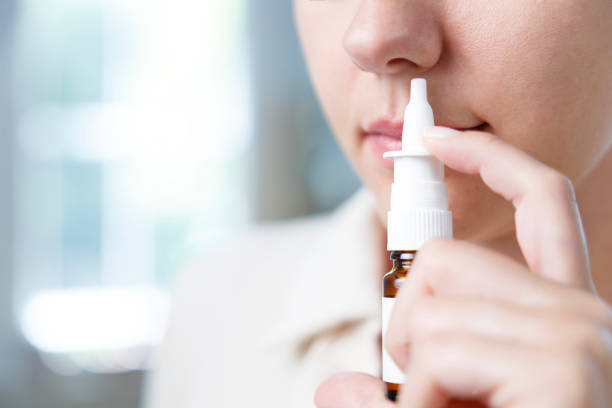USP Nasal Spray Microbial Limit Testing
The USP Nasal Spray Microbial Limit Test is a critical procedure designed to ensure that nasal sprays are free from excessive microbial contamination, thereby protecting consumer health. This test adheres strictly to United States Pharmacopeia (USP) standards and guidelines which specify the acceptable levels of microorganisms in pharmaceutical products intended for inhalation or topical application.
The test aims to prevent potential infections caused by harmful bacteria, fungi, and other pathogens that could be present on nasal sprays. Given the intimate contact these products have with mucous membranes, even a low level of microbial contamination can pose significant risks. The USP guidelines provide specific limits for the number of microorganisms allowed in each milliliter or gram of product, depending upon the dilution used during testing.
The process involves several key steps:
- Sampling: A precise amount of the nasal spray is collected using a sterile container.
- Dilution: The sample is then diluted in an appropriate buffer solution to enhance sensitivity and accuracy.
- Culture: Diluted samples are inoculated onto suitable media that supports microbial growth.
- Incubation: The inoculated plates are incubated under controlled conditions, typically at 35°C for 48 hours.
- Counting: After the incubation period, colonies on the plates are counted to determine the total viable count (TVC).
The results of this test play a pivotal role in ensuring product safety and compliance with regulatory requirements. Regulatory agencies such as the FDA often mandate that pharmaceutical products undergo microbial testing before being approved for sale. By adhering to these stringent standards, manufacturers can demonstrate their commitment to quality and patient safety.
Moreover, the USP Nasal Spray Microbial Limit Test helps in identifying any potential issues early on in the production process. This proactive approach allows companies to address contamination risks promptly, thereby preventing costly recalls and maintaining brand integrity. In addition, it supports ongoing compliance with international standards such as ISO 17895:2016, which outlines best practices for microbiological quality assurance.
For R&D engineers working on developing new nasal spray formulations, this test provides valuable insights into the stability of their products under various conditions. It also ensures that any changes made during formulation do not inadvertently increase microbial load beyond acceptable limits. For quality managers and compliance officers, ensuring consistency in testing procedures across different batches is crucial for maintaining high standards throughout production cycles.
The precision and reliability of USP Nasal Spray Microbial Limit Testing are further enhanced by advanced laboratory instrumentation such as automated colony counters and specialized media that facilitate rapid detection of microorganisms. These tools not only speed up the testing process but also minimize human error, leading to more accurate results.
Why It Matters
The importance of USP Nasal Spray Microbial Limit Testing cannot be overstated in the context of pharmaceutical manufacturing and quality control. Ensuring that nasal sprays meet strict microbial limits is essential for several reasons:
- Consumer Safety: Excessive microbial contamination can lead to serious health risks, including infections and allergic reactions.
- Regulatory Compliance: Failure to comply with USP standards could result in product recalls, legal action, and reputational damage for pharmaceutical companies.
- Product Integrity: Maintaining consistent microbial limits helps protect the integrity of nasal spray products throughout their shelf life.
- Patient Trust: Demonstrating adherence to rigorous testing protocols instills confidence among consumers about the safety and efficacy of a product.
In an era where public health concerns are increasingly prominent, manufacturers must prioritize measures that safeguard end-users. By implementing robust microbial limit tests early in the development stage, companies can mitigate risks associated with microbial contamination and enhance overall product quality.
Industry Applications
The USP Nasal Spray Microbial Limit Test finds application across various sectors within the pharmaceutical industry, particularly those focused on inhalation and nasal products. These include:
- Ophthalmic Products: Eye drops and other ocular medications also require thorough microbial testing to ensure they meet regulatory standards.
- Nasal Sprays: Medications designed for direct application into the nasal passages, such as decongestants or steroid sprays.
- Inhalers: Inhalation devices used for delivering medication directly into the lungs via aerosolized particles.
Beyond these specific applications, this testing method extends its utility to broader areas of pharmaceutical research and development. It supports innovations in nasal spray formulations while ensuring that all changes comply with established guidelines. Additionally, it facilitates quality assurance processes during large-scale production runs, helping maintain consistency across different batches.
Competitive Advantage and Market Impact
In today's competitive pharmaceutical market, maintaining strict adherence to USP standards can significantly enhance a company’s reputation and market standing. Here are some ways in which rigorous microbial limit testing contributes to business success:
- Enhanced Reputation: Consistently meeting or exceeding regulatory expectations builds trust with consumers and healthcare professionals.
- Innovation Support: By identifying potential contamination issues early, companies can innovate more effectively without compromising product safety.
- Cost Efficiency: Proactive testing reduces the likelihood of costly recalls and legal disputes. It also minimizes waste associated with substandard products.
- Market Leadership: Demonstrating a commitment to quality through reliable microbial limit tests can differentiate a company from competitors, potentially leading to increased market share.
The demand for safe and effective pharmaceutical products is growing globally. As consumer awareness of health risks increases, so does the expectation that manufacturers will go above and beyond to protect public welfare. Companies that prioritize thorough testing like USP Nasal Spray Microbial Limit Testing are well-positioned to meet these expectations and capitalize on opportunities in emerging markets.





